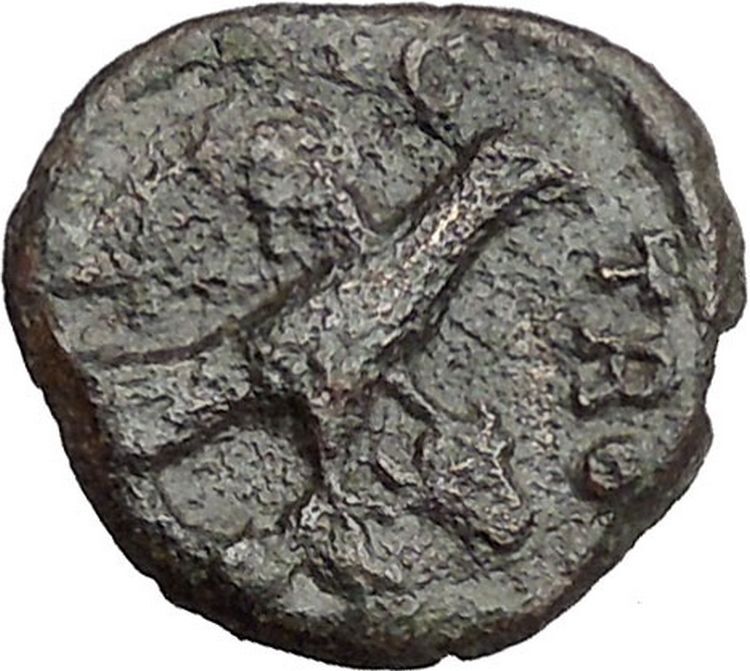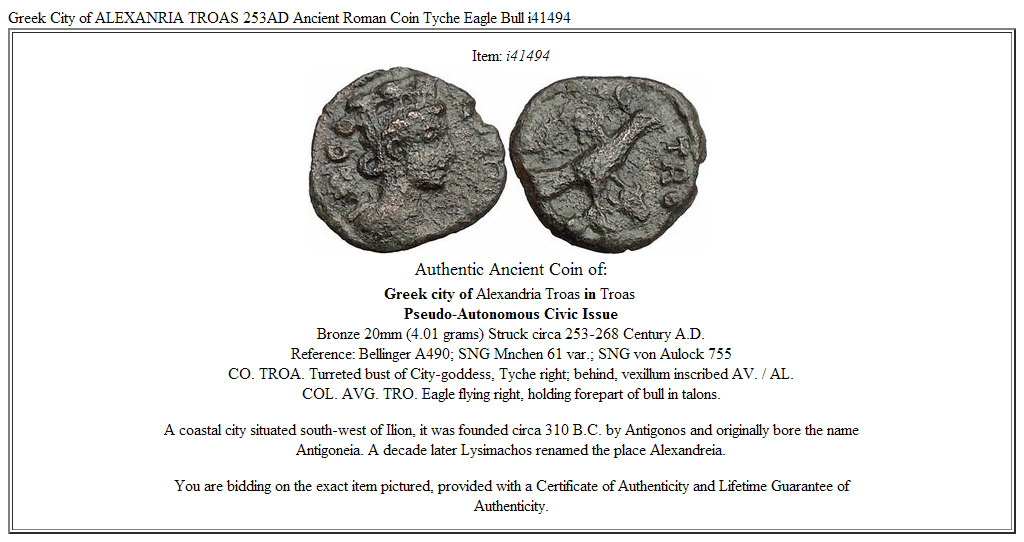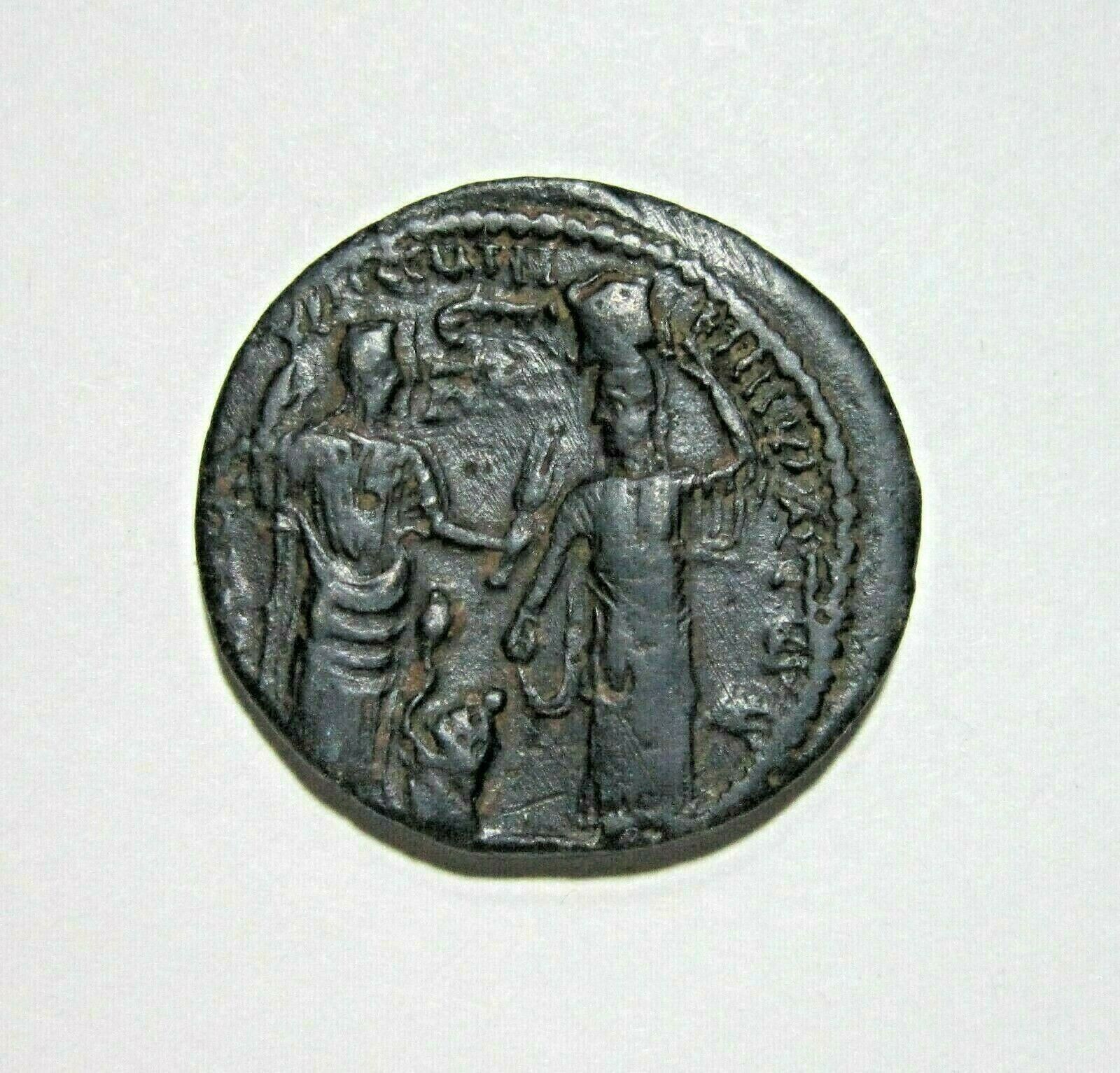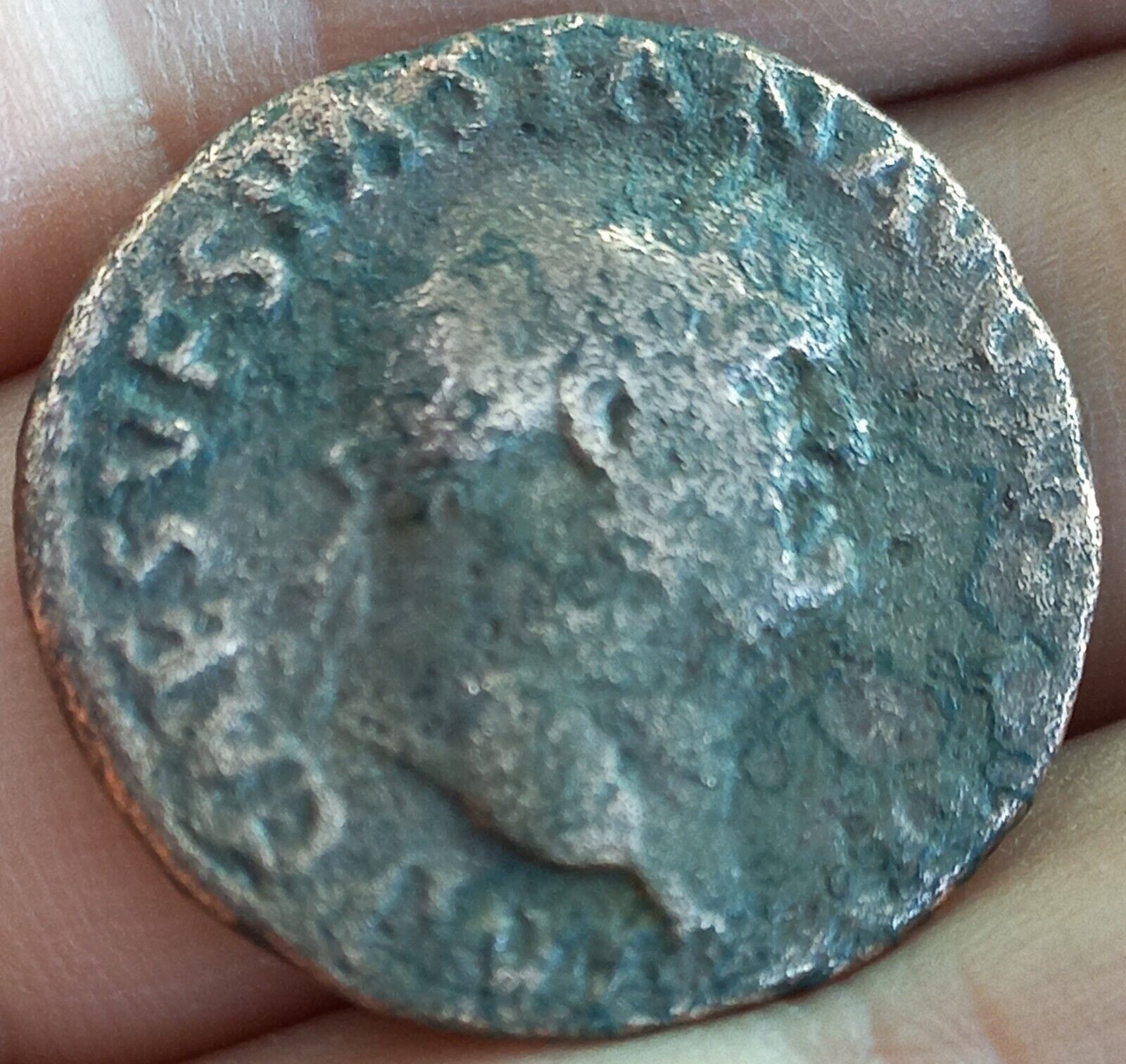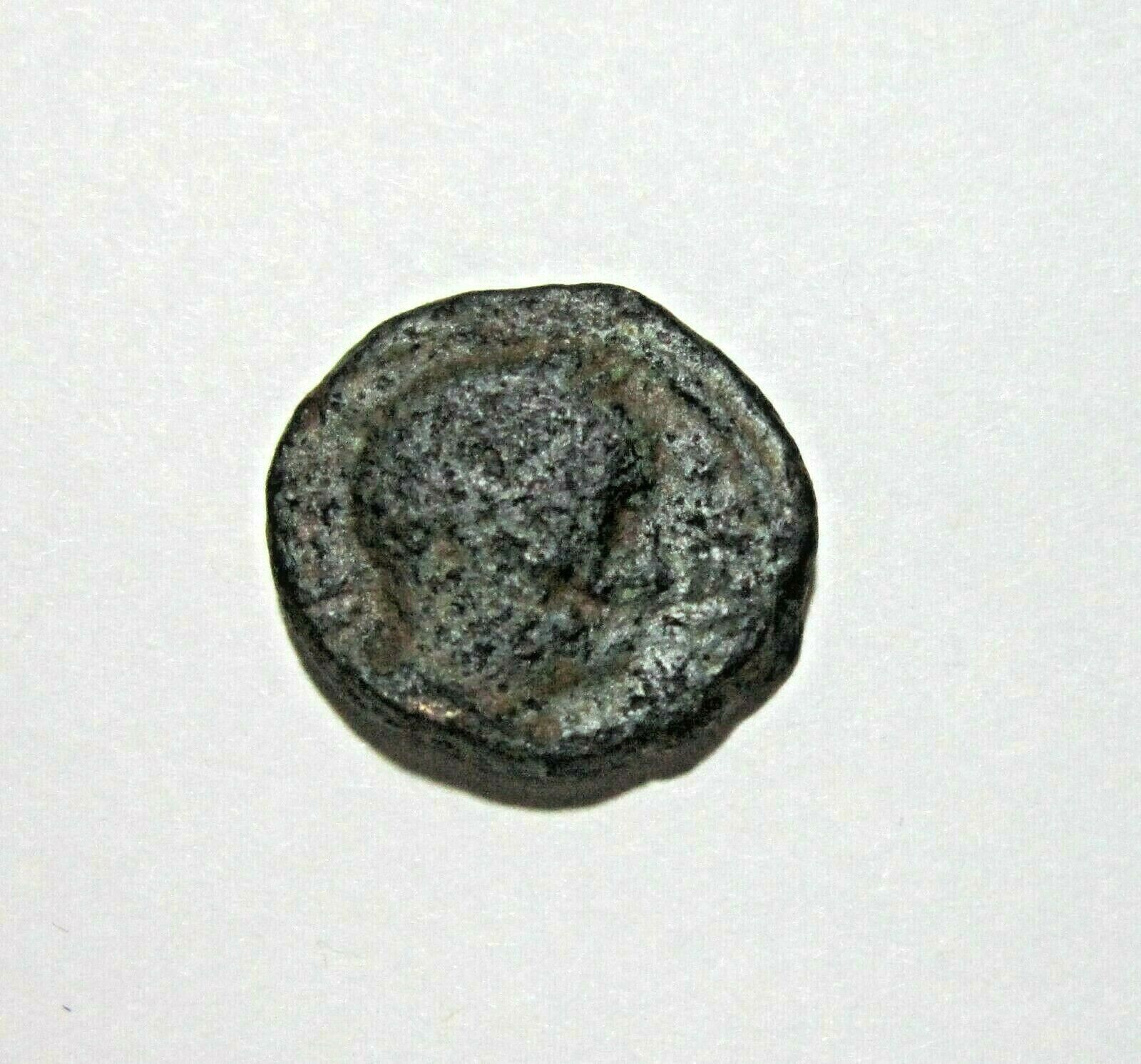-40%
Greek City of ALEXANRIA TROAS 253AD Ancient Roman Coin Tyche Eagle Bull i41494
$ 52.8
- Description
- Size Guide
Description
Item:i41494
Authentic Ancient Coin of:
Greek city of
Alexandria Troas
in
Troas
Pseudo-Autonomous Civic Issue
Bronze 20mm (4.01 grams) Struck circa 253-268 Century A.D.
Reference: Bellinger A490; SNG München 61 var.; SNG von Aulock 755
CO. TROA. Turreted bust of City-goddess, Tyche right; behind, vexillum inscribed AV. / AL.
COL. AVG. TRO.
Eagle
flying right, holding forepart of bull in talons.
A coastal city situated south-west of Ilion, it was founded circa 310 B.C. by Antigonos and originally bore the name Antigoneia. A decade later Lysimachos renamed the place Alexandreia.
You are bidding on the exact item pictured, provided with a Certificate of Authenticity and Lifetime Guarantee of Authenticity.
Tyche (Greek for luck; the Roman equivalent was
Fortuna
) was the presiding
tutelary deity
that governed the fortune and prosperity of a city, its destiny. Increasingly during the Hellenistic period, cities had their own specific iconic version of Tyche, wearing a
mural crown
(a crown like the walls of the city).
The Greek historian
Polybius
believed that when no cause can be discovered to events such as floods, droughts, frosts or even in politics, then the cause of these events may be fairly attributed to Tyche.
Stylianos Spyridakis concisely expressed Tyche's appeal in a Hellenistic world of arbitrary violence and unmeaning reverses: "In the turbulent years of the
Epigoni of Alexander
, an awareness of the instability of human affairs led people to believe that Tyche, the blind mistress of Fortune, governed mankind with an inconstancy which explained the vicissitudes of the time."
In literature, she might be given various genealogies, as a daughter of
Hermes
and
Aphrodite
, or considered as one of the
Oceanids
, daughters of
Oceanus
and
Tethys
, or of
Zeus
. She was connected with
Nemesis
and
Agathos Daimon
("good spirit").
She was uniquely venerated at
Itanos
in Crete, as
Tyche Protogeneia
, linked with the Athenian
Protogeneia
("firstborn"), daughter of
Erechtheus
, whose self-sacrifice saved the city.
She had temples at
Caesarea Maritima
,
Antioch
,
Alexandria
and
Constantinople
. In
Alexandria
the
Tychaeon
, the temple of Tyche, was described by
Libanius
as one of the most magnificent of the entire Hellenistic world.
Tyche appears on many
coins
of the Hellenistic period in the three centuries before the Christian era, especially from cities in the Aegean. Unpredictable turns of fortune drive the complicated plotlines of
Hellenistic romances
, such as
Leucippe and Clitophon
or
Daphnis and Chloe
. She experienced a resurgence in another era of uneasy change, the final days of publicly sanctioned
Paganism
, between the late-fourth-century emperors
Julian
and
Theodosius I
who definitively closed the temples. The effectiveness of her capricious power even achieved respectability in philosophical circles during that generation, though among poets it was a commonplace to revile her for a fickle harlot.
In
medieval art
, she was depicted as carrying a
cornucopia
, an
emblematic
ship's rudder, and the
wheel of fortune
, or she may stand on the wheel, presiding over the entire circle of fate.
The constellation of
Virgo
is sometimes identified as the heavenly figure of Tyche, as well as other goddesses such as
Demeter
and
Astraea
.
Alexandria Troas
("Alexandria of the
Troad
", modern
Turkish
:
Eski Stambul
) is an ancient
Greek
city situated on the
Aegean Sea
near the northern tip of
Turkey
's western coast, a little south of
Tenedos
(modern
Bozcaada
). It is located in the modern Turkish province of
Çanakkale
. The site sprawls over an estimated 400 hectares (1,000 acres); among the few structures still extant today are a ruined bath and gymnasium complex and a recently uncovered stadium.
Aleaxandria Troas Therme
History
Hellenistic
According to
Strabo
, this site was first called
Sigeia
; around 306 BC
Antigonus
refounded the city as the much-expanded
Antigonia Troas
by settling the people of five other towns in Sigeia, including the once influential city of
Neandria
. Its name was changed by
Lysimachus
to Alexandria Troas, in memory of
Alexander III
of Macedon
(
Pliny
merely states that the name changed from Antigonia to Alexandria). As the chief port of north-west Asia Minor, the place prospered greatly in Roman times, becoming a "free and autonomous city" as early as 188 BC,
[3]
and the existing remains sufficiently attest its former importance. In its heyday, the city may have had a population of about 100,000.
Strabo
mentions that a
Roman
colony
was created at the location in the reign of
Augustus
, named
Colonia Alexandria Augusta Troas
(called simply
Troas
during this period). Augustus,
Hadrian
and the rich grammarian
Herodes Atticus
contributed greatly to its embellishment; the aqueduct still preserved is due to the latter.
Constantine
considered making Troas the capital of the
Roman Empire
.
Roman
In Roman times, it was a significant port for travelling between
Anatolia
and Europe.
Paul
of Tarsus
sailed for Europe for the first time from Alexandria Troas and returned there from Europe (it was there that the episode of the raising of
Eutychus
later occurred).
Ignatius of Antioch
also paused at this city before continuing to his martyrdom at Rome.
Byzantine
Several of its later
bishops
are known: Marinus in 325; Niconius in 344; Sylvanus at the beginning of the 5th century; Pionius in 451; Leo in 787; Peter, friend of the
Patriarch Ignatius
, and adversary to Michael, in the ninth century. In the 10th century Troas is given as a suffragan of
Cyzicus
and distinct from the famous
Troy
(
Heinrich Gelzer
,
Ungedruckte ... Texte der Notitiae episcopatuum
, 552;
Georgii Cyprii descriptio orbis romani
, 64); it is not known when the city was destroyed and the diocese disappeared. The city remains a
titular see
of the
Roman Catholic Church
,
Troadensis
; the seat is vacant following the resignation of the last bishop in 1971.
Troas is also a titular see of the
Orthodox Church
under the
Ecumenical Patriarchate
. The most recent hierarch, His Grace Bishop Savas (Zembillas) of Troas, served 2002-2011. He is now
Metropolitan Savas (Zembillas) of Pittsburgh
in the
Greek Orthodox Archdiocese of America
.
Ottoman
Karasid
Turkomans
settled in the area of the Troad in the 14th century. Their
beylik
was conquered by the Ottomans in 1336. The ruins of Alexandria Troas came to be known among the Turks as
Eski Stambul
, the "Old City". The site's stones were much plundered for building material (for example
Mehmed IV
took columns to adorn his
Yeni Valide Mosque
in
Istanbul
). As of the mid-18th century the site served as "a lurking place for bandetti".
Modern
By 1911 the site had been overgrown with
vallonea oaks
and much plundered, but the circuit of the old walls could still be traced, and in several places they were fairly well preserved. They had a circumference of about ten kilometres, and were fortified with towers at regular intervals. Remains of an ancient bath and gymnasium complex can be found within this area; this building is locally known as
Bal Saray
(Honey Palace) and was originally endowed by Herodes Atticus in the year 135.
Trajan
built an aqueduct which can still be traced. The harbour had two large basins, now almost choked with sand. It is the subject of a recent study by German archaeologists who are digging and surveying at the site. Their excavation has uncovered the remains of a large stadium dating to about 100 BC.
Frequently Asked Questions
How long until my order is shipped?
Depending on the volume of sales, it may take up to 5 business days for shipment of your order after the receipt of payment.
How will I know when the order was shipped?
After your order has shipped, you will be left positive feedback, and that date should be used as a basis of estimating an arrival date.
After you shipped the order, how long will the mail take?
USPS First Class mail takes about 3-5 business days to arrive in the U.S., international shipping times cannot be estimated as they vary from country to country. I am not responsible for any USPS delivery delays, especially for an international package.
What is a certificate of authenticity and what guarantees do you give that the item is authentic?
Each of the items sold here, is provided with a Certificate of Authenticity, and a Lifetime Guarantee of Authenticity, issued by a world-renowned numismatic and antique expert that has identified over 10000 ancient coins and has provided them with the same guarantee. You will be quite happy with what you get with the COA; a professional presentation of the coin, with all of the relevant information and a picture of the coin you saw in the listing.
Compared to other certification companies, the certificate of authenticity is a -50 value. So buy a coin today and own a piece of history, guaranteed.
Is there a money back guarantee?
I offer a 30 day unconditional money back guarantee. I stand behind my coins and would be willing to exchange your order for either store credit towards other coins, or refund, minus shipping expenses, within 30 days from the receipt of your order. My goal is to have the returning customers for a lifetime, and I am so sure in my coins, their authenticity, numismatic value and beauty, I can offer such a guarantee.
Is there a number I can call you with questions about my order?
You can contact me directly via ask seller a question and request my telephone number, or go to my About Me Page to get my contact information only in regards to items purchased on eBay.
When should I leave feedback?
Once you receive your order, please leave a positive. Please don't leave any negative feedbacks, as it happens many times that people rush to leave feedback before letting sufficient time for the order to arrive. Also, if you sent an email, make sure to check for my reply in your messages before claiming that you didn't receive a response. The matter of fact is that any issues can be resolved, as reputation is most important to me. My goal is to provide superior products and quality of service.
